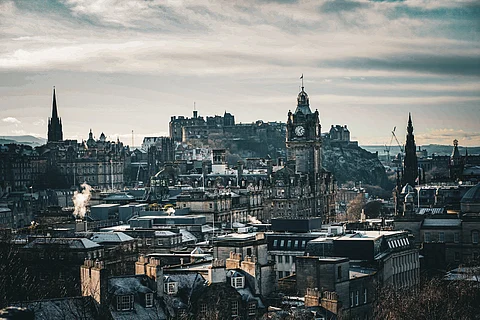
- Destinations
- Experiences
- Stay
- What's new
- Celebrating People
- Responsible Tourism
- CampaignsCampaigns
- SubscribeSubscribe
- Buy Now

It is for good reason that Scotland continues to draw filmmakers and cinephiles alike to its brooding highlands, mysterious lochs, mediaeval cities and Gothic ruins: all come together and form the perfect backdrop for a visual drama of great narrative depth. Even beyond the majestic scenic assistance that Scotland lends to its film, it also stores a rich history of storytelling and has long been a home for classic literature, social realism as well as fantasy. Whether you're tracing Mark Renton's (played by Ewan McGregor) iconic sprint through Edinburgh in Trainspotting, wandering the glens featured in Skyfall, or stepping onto the eerie moors of The Wicker Man, Scotland's cinematic history is as layered as it is inexhaustible. Here is a guide to exploring Scotland's best as far as cinema is concerned.
Few cities have had as turbulent as magnetic a relationship with the big screen as Edinburgh. Trainspotting (1996), Danny Boyle's topping delivery which is an adaptation of the eponymous book by Irvine Welsh, is the film that is most associated with the capital. Though largely shot in Glasgow for budget reasons, the film's opening sequence—Renton and Spud sprinting down Princes Street—remains one of the most iconic sequences of modern British cinema and is epitomised in the phrase: Choose life! Cinephiles can pay a visit to the area near Calton Road, the scene of many of the film's urban backdrops, or explore Leith, the gritty neighbourhood immortalised in the novel.
To speak of more recent affairs, it is well known that Edinburgh featured in Avengers: Infinity War (2018), in which Scarlet Witch and Vision fight Thanos's Black Order on the Royal Mile and inside Waverley Station. The juxtaposition of Hollywood spectacle with the city's mediaeval sites and neoclassical skyline underscores Edinburgh's adaptability on the big screen.
For those with a soft spot for the more literary cinema, Greyfriars Bobby (1961), The Prime of Miss Jean Brodie (1969), and the adaptation of Muriel Spark's novel all lend themselves to an architectural tour of the city, with locations around Greyfriars Kirk, George Heriot's School and the Grassmarket.
Glasgow, Scotland's largest city, has come to be a go-to location for filmmakers, especially those who seek to replicate various cities from around the world. With its Victorian architecture and grid layout, it has doubled for Philadelphia (World War Z), San Francisco (Cloud Atlas) as well as Gotham City (The Flash, 2023).
However, Glasgow is also central to the emergence of Scotland's hard-hitting social realist cinema. Red Road (2006), directed by the unique Andrea Arnold, made use of the high-rise flats of the Red Road estate as a haunting symbol of urban isolation and voyeurism: two themes recurrent in the Arnold oeuvre. Ratcatcher (1999), Lynne Ramsay's poetic encapsulation of childhood during Glasgow's 1973 bin strike, further cements the city's place in gritty, reflective and confrontational British cinema.
A traveller in the city must dawdle around Govan's riverside walkways to see the setting of Ramsay's work or head to Glasgow Cathedral, featured in Outlaw King (2018) for a more historical backdrop.
From sweeping aerial shots to moody golden hour sequences, the Scottish Highlands have long shaped the tone of many films. Most famously, Glen Etive featured in Skyfall (2012), where James Bond returns to his childhood home. The road leading to Glen Etive is a bucket-list destination for Bond fans and those looking to soak in the cinema history of Scotland.
Braveheart (1995), despite its historical inaccuracies, embedded the Highlands into the popular consciousness with its romanticised visions of Scottish freedom. While much of it was shot in Irelands, the echoes of the film's spirit are found in Glen Nevis and the Wallace Monument in Stirling.
Cult favourite The Wicker Man (1973) was filmed on various Scottish islands and mainland locations, including the Plockton and Culzean Castle, bringing together eerie folk horror with mesmerising natural scenery.
The two-pronged appeal of the Isle of Skye that involves both rugged landscape as well as surreal natural beauty makes for the natural setting of fantasy and sci-fi alike. Ridley Scott's Prometheus (2012) opens up with a sequence that casts the sweeping shots of the island's Old Man of Storr and Quiraing—landscapes so ancient and stark that they feel novel.
Parts of the film Macbeth (2105), starring the inimitable Michael Fassbender and Marion Cotillard, were also filmed in the Hebrides, where the raw terrain adds to the film's intensely tragic mood. You can visit the Fairy Pools or Neist Point for landscapes that capture this bleak poetry.
Scotland's literary heritage has been a rewarding source for cinema for a long time. Rober Louis Stevenson's Kidnapped, Lewis Grassic Gibbon's Sunset Song and Alasdair Gray's Lanark have all found screen interpretations, the latter through animated and experimental projects. Notably, Terence Davies's Sunset Song (2015) captured the lyrical intensity of bucolic life in early 20th-century Scotland, shot largely in Aberdeenshire and around Glenesk.
Another must-watch is the Bill Douglas's Trilogy (1972-78), a hauntingly minimalist set of films inspired by his childhood in Newcraighall, near Edinburgh. Deeply autobiographical and notoriously poetic, they're essential viewing for any serious cinephilia around Scotland.
If you’re travelling as a cinephile, time your visit with the Edinburgh International Film Festival (EIFF)—the world’s longest continually running film festival, founded in 1947. It’s an excellent platform for Scottish filmmakers and global indie voices alike.
The Glasgow Film Festival, held every February, is another major draw, known for eclectic programming and a focus on experimental cinema. Pair this with a visit to the Scottish Screen Archive or a screening at the Glasgow Film Theatre (GFT)—one of the country’s oldest arthouse cinemas.
